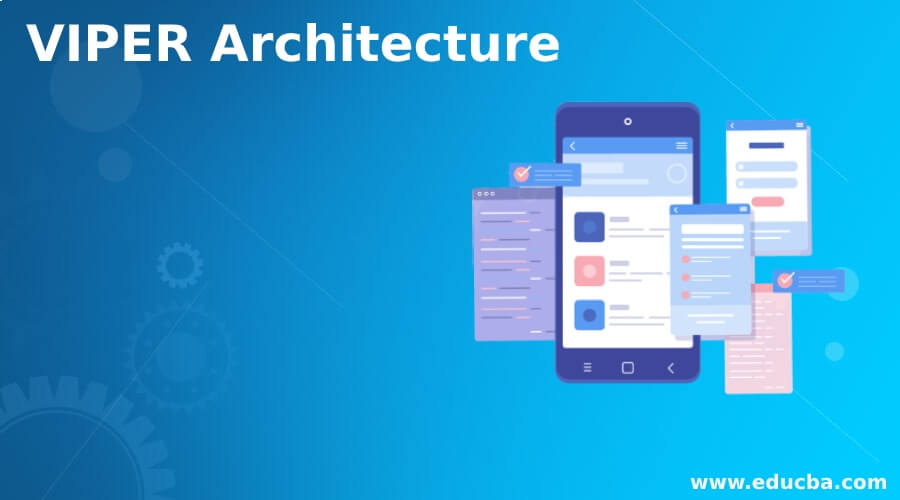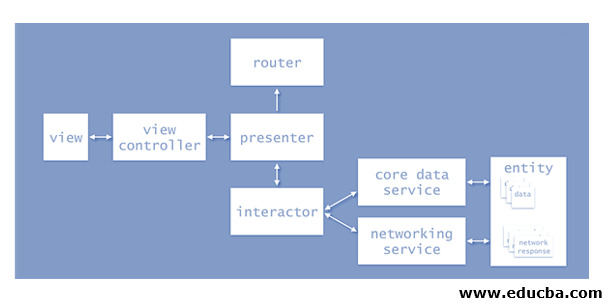Updated March 28, 2023

Introduction to VIPER Architecture
The following article provides an outline for VIPER Architecture. A generic template that is used to solve any particular issues or situation is based on the software design pattern. These architectural patterns have a huge impact on the entire code, which is completely generic. VIPER is one of the iOS design patterns and reliable infrastructure. The approach is significant to design the code, but it has some inbuilt logics that merge to form a logical method fed into an architecture. The VIPER is used to develop many huge projects and many applications.
VIPER Architecture with Diagram
Testing is not that important part at the time of building iOS applications. But it is embarked that testing in applications was difficult. So VIPER is developed to increase the method to test the software in a better way in the application architecture. VIPER provides the defined architecture to iOS applications in all the mobile and software components. The VIPER is expanded as View, Interactor, Presenter, Entity, and Routing. This defined architecture of VIPER segregates the logical structure of an application into distinct layers inbuilt with individual responsibility.
So it made the applications and process divide the dependencies and trail communications at boundaries in between every layer. The distinct layer of VIPER supports by feeding an accurate location and application on logic and related codes for navigation. With the application of VIPER, the view controllers in the examples are mean, lean, and display the controlling machines. The code is easy to test and understand; it is used for periodic maintenance. The architecture of VIPER is dependent on the principle of single responsibility, which is used as a theorem to built a clean architecture.
Components of VIPER Architecture
The important and core elements of VIPER architecture is given below:
- The view is an interface section that insists on UIKit files, which are in subclasses of the UIVIEW controller and all other schedules. The component View doesn’t perform anything which is associated with business logic. It is a forwarding section and presentation layers that the presenter implements. Because the view is used to manage the controller based on MVVM principles or data administrators to enhance the projects and application more concisely.
- The interactor is a responsible component that is used for revoking the data from the model layer, and its implementation process doesn’t rely on the user interface. It is important that all the data executives on the database, network, and sensors are not part of VIPER sections and are treated as individual components, which are services received from external components to VIPER modules, and they can be inserted as additions for interactors. The interactor can formulate the data which is received from the service layer. It can be used to filter or sort the data before any incoming network services to save the data. The tool interactor has no idea for the preparation of data and responsibility of the presenter.
- The presenter is a core class of the VIPER module. Here the UIKit independent class formulates the data in a proper format that is needed by view and decision on UI events from view. It is mentioned as an event manager. It interacts with the interactor and demands the router to frame the wire for routing purposes. The significant role of the presenter is to interact with all the components from classes and accomplish the task. It doesn’t have control of UIKit or minimum-level data models. However, it is a crucial part of the application where all the business logic is implemented.
- The entity is defined as plain model classes that are executed by interactors. So, for example, the outside of the VIPER module is an entity that is the service layer as its distributed across the entire system. But it doesn’t separate the module, which cannot be generated in one place. Instead, it is similar to a swagger concept that the core data model can generate.
- The router is a component used for navigation logic which is used in UIKit classes. If the user uses the same iPad and iPhone view on both applications, which changes the structure of the router. It enables the user to maintain everything without disturbing the router. It guides the flow of navigation from the presenter and displays the proper screen is required. If it is needed to select any external link, then the URL is evoked to call internal to router. It is a part of routing action, and similar logic is implemented on social media to share the functions of UIactivityviewcontroller. If the user has to share the data between VIPER modules, then it is a suitable place to execute in the router. So it is generally communicated between a delegation of the pattern. Hence the delegate functions are implemented in the router.
- Builder is used to developing a whole module by injecting dependencies for external services. Because few admins are implementing routers for building purposes. So a concerned module is developed to build and mock another version of a particular module. In addition, the builder supports unit testing, which is helpful to enhance the productivity of the process and applications.
Advantages
Given below are the advantages of VIPER Architecture:
- Even though the VIPER is criticized for its complexity, it has many other markable benefits. So there are many benefits in implementing the VIPER to design our software tools.
- It provides simplicity for higher-dimensional teams and complex projects.
- The scalability of VIPER is linear and works persistently to perform many parallel operations.
- The codes of VIPER is reusable and decoupled to many components based on their responsibilities.
- The clarity and consistency of VIPER are used in the separation of modules.
- VIPER provides easy bug fixing, testability, and source control. Because of the small chunks of codes, debugging is easy and faster. The modules are built with well-described scopes of interfaces. The simple source control with pure code has fewer conflicts used to trace the location of problems and bugs.
Recommended Articles
This is a guide to VIPER Architecture. Here we discuss the Viper Architecture with diagram, components, and advantages, respectively. You may also have a look at the following articles to learn more –


